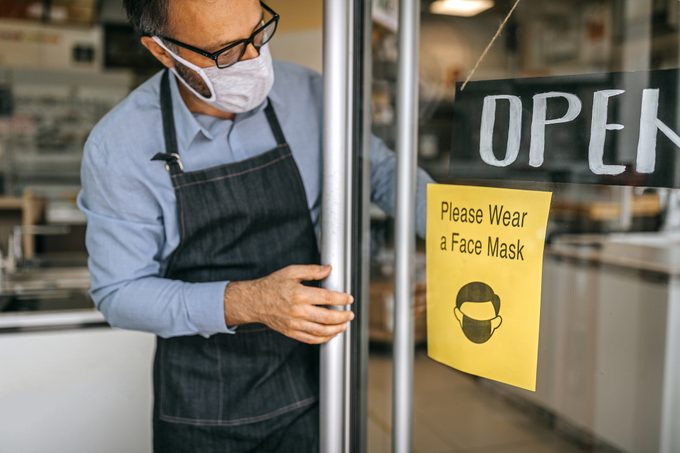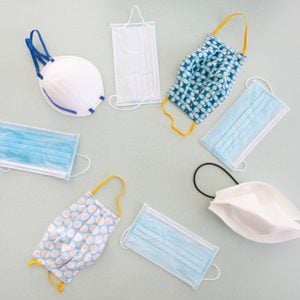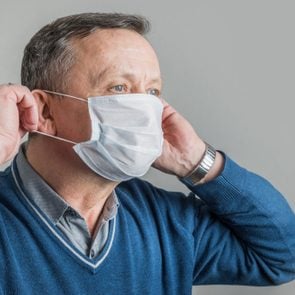Why Fully Vaccinated People Might Still Need Masks, Even with the CDC’s Updated Guidelines
Updated: Feb. 28, 2022
The Centers for Disease Control and Prevention (CDC) has updated the current recommendation on mask-wearing. Here's the latest, plus more on the status of Covid-19 as we move into the first week of March.
Keeping up with Covid-19 updates
It was March 11, 2020, when the World Health Organization declared the Covid-19 pandemic. After two years of adaptations to masking guidelines based mostly on nationwide infection rates, the Centers for Disease Control and Prevention (CDC) is offering a Covid-19 masking system that’s based on rates of new cases, new hospital admissions, and hospital capacity within an individual county.
Here’s how the new CDC masking guideline works
Communities can have high (orange), medium (yellow), or low (green) circulating Covid-19 levels based on the new hospital data-based guidelines. Those counties that fall into the green or yellow categories no longer need to wear masks, as long as the numbers don’t start creeping up. People (including children in schools) living in areas with high disease levels should still wear masks, according to the new guidance.
How do you know which level applies to you? The CDC offers a new “county check tool” online at CDC.gov or by calling 800-232-4636.
As of February 28, about 70 percent of the U.S. population lives in a place where they no longer need to wear a mask based on this new system. Masks to help prevent the spread of Covid-19 are still required on buses, trains, and planes until at least March 18, 2022, when the current order is set to expire. (Also read 14 Signs You May Have Already Had Covid-19, Doctors Reveal.)
Is it time to stop wearing your Covid-19 mask?
If you’re curious about what the CDC’s new masking recommendation means for you, here’s one cautionary rule of thumb, according to public health specialists: just because you can remove your mask doesn’t necessarily mean you should. “Getting rid of masks is ill-advised because the numbers are still quite high compared to how low they have been [at certain points] in the past,” Otto Yang, MD, an immunologist at the David Geffen School of Medicine at the University of California, Los Angeles, told The Healthy on February 28, 2022.
Yes, the number of new Covid-19 cases across the country has decreased, but it’s still not zero. Covid-19 infection data also varies widely from region to region, Dr. Yang points out. To date, almost 79 million people in the U.S. have been infected with SARS-CoV-2, the virus that causes Covid-19—and unfortunately, people are still dying from the virus. “The new recommendations are like saying, ‘The fire has changed from raging to moderate, so let’s back off on fighting it,'” Dr. Yang says.
Masks may feel like a nuisance, but they are a small price to pay for saving a life. “It’s a matter of public health, not personal health,” suggests Dr. Yang.
Masks work
Multiple studies confirm that masks work to slow Covid-19 infections. “If you look at all the evidence, wearing a mask helps prevent both the person who’s wearing the mask from spreading respiratory droplets and from acquiring the virus,” says S. Wesley Long, MD, PhD, medical director of diagnostic microbiology at Houston Methodist.
But you need the right mask, and to wear it correctly. “The fit of the mask is key, even with a cloth mask,” says Jennifer Balkus, PhD, assistant professor of epidemiology at the University of Washington School of Public Health. That means “ensuring that it’s fitting snugly on the bridge of your nose and under the chin,” Dr. Balkus says. “It should be breathable without gaps around the nose and chin.”
Surgical and N95 or KN95 masks are better—but, for cloth masks, aim to have at least two layers of fabric cotton or cotton blend, Dr. Balkus suggests.
“Intelligent masking” may be an option, says Aaron E. Glatt, MD, an Infectious Diseases Society of America (IDSA) spokesperson, chairman of medicine at Mount Sinai South Nassau and professor of medicine at Icahn School of Medicine at Mount Sinai in New York City. “There are certain situations where it’s absolutely necessary, and others where it’s not, then a huge gray area in between,” says Dr. Glatt.
Small indoor spaces which are poorly ventilated and where you don’t know the vaccination status of other occupants is one situation where mask wearing is highly advisable. If you’re in a large indoor space without a lot of people and you know they’re all vaccinated, then wearing a mask may be less necessary.
You have to gauge your own risk, taking into account your age, your health, and whether or not you’re vaccinated, says Dr. Glatt. And now, pay close attention to local trends.
Masks also provide protection against other pathogens
When it’s come to masks, for the past two years most of our attention has been focused on Covid-19. But masks can protect against other nasty bugs as well, Dr. Yang points out.
Illustrating this, a study co-authored by Dr. Long and published in September 2021 found that Covid-19 mitigation measures also beat back other respiratory diseases. “Once everything went on lockdown for Covid-19, other pathogens basically went to zero in a couple of weeks,” Dr. Long says. “There were no other respiratory pathogens until measures started being relaxed. When mask orders were rescinded, we saw a huge resurgence of non-Covid respiratory illnesses.”
The new bottom line on masking
The new CDC guidance is just that—guidance, says Howard P. Forman, MD, a professor of public health at Yale University in New Haven, CT. Dr. Forman adds that the virus is a moving target. “It can endure through surges and periods that are lower in transmission, which is where a lot of country is right now,” he says.
There is still a small part of the population at higher risk for severe Covid-19. The vaccines, though highly effective, may not be able to people who have weakened immune systems, he says. Whether they take immunosuppressive drugs after an organ transplant, are undergoing chemotherapy, have HIV or AIDS, or another condition, by nature, these individuals simply don’t experience as much protection. “Having people wear masks around these individuals provides additional protection that otherwise would not be available to them,” Dr. Forman says. “The new CDC guidance is good as a public health measure, but it should be overlaid with your own personal risks and your family’s risks.”
It’s also still important to wash hands often and use hand sanitizer when soap and water aren’t readily available, and to stay home when you are feeling under the weather, he says.
Vaccinated people and Covid-19 infection
The three existing Covid-19 vaccines are still effective against the Omicron variant, but not quite as effective as they are against the original strain of the virus or the recent Delta variant. That means you can get infected and sick, even if your Covid vaccinations are up to date (that’s two shots of Johnson & Johnson and three of Moderna or Pfizer, including boosters). As you may already know, these cases are known as breakthrough infections.
And while breakthrough infections are usually relatively mild in vaccinated people compared to infections in unvaccinated people, they can be serious in some cases. “I’ve seen breakthrough infections where people have been hospitalized, and we still don’t know the risk of post-Covid complications,” says Ravina Kullar, PharmD, a fellow of the Infectious Diseases Society of America and adjunct faculty at UCLA David Geffen School of Medicine.
The Omicron variant is still dominant
Ninety or more percent of Covid cases are still Omicron, says Georges Benjamin, MD, executive director of the American Public Health Association. It’s worth noting that in recent weeks, there has also been a subvariant of Omicron, known as BA.2, that’s been floating around.
Right now, there’s no evidence to suggest BA.2 will overtake the original Omicron, says Dr. Benjamin, but that doesn’t mean there won’t be a new variant coming down the line. As long as people remain unvaccinated, the virus will mutate. This means masks continue to be important to protect you against the unknown.
Infected vaccinated people can still spread the virus
Anyone who tests positive for Covid-19, vaccinated or unvaccinated, can still transmit the virus. This is true whether or not you have symptoms, says Dr. Kullar. And Omicron is significantly more infectious than earlier strains. “The Omicron variant has been found to be four times more infectious than the original Wuhan strain, and two times more infectious than Delta,” adds Dr. Kullar.
The vaccine may not fully protect the immunocompromised
That’s why the Food and Drug Administration previously authorized additional doses of Pfizer or Moderna for people in this category. Some immunocompromised people are already receiving second boosters to bring their immune protection up to speed, says Luis Ostrosky, MD, professor of infectious disease with McGovern Medical School at UTHealth in Houston.
If you are positive for SARS-CoV-2, no matter your vaccination status, there’s still a possibility you could infect someone who has a higher chance of becoming severely ill.
The vaccines grow less effective over time
That’s why boosters are now commonplace—but even the boosters lose power over time. A CDC study published on February 11, 2022 reported that efficacy of boosters waned considerably after four months. Vaccines were 91 percent effective against being hospitalized after two months, but only 78 percent effective by the fourth months.
Still, in the world of immunology, experts say those are good numbers. “We have clear evidence that being up to date with vaccinations protects you from landing in the hospital and dying,” says Dr. Ostrosky.
Sign up for The Healthy newsletter to stay up on the latest. Plus, get more wellness insight right here:
- Exhausted From Living Through Stressful Events? A Resilience Expert’s 6 Tips to Stay Encouraged
- Shoveling Snow, Heart Attack, and Stroke: 3 Heart Doctors Share Their Insights on Staying Safe
- Doctors Say Knowing About This Vaccine Could Cut Your Cancer Risk Significantly
- Got Your Covid-19 Vaccine Card? 4 Things You Should Do Right Away





